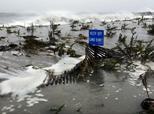 By Dr. Eli Shapiro
By Dr. Eli Shapiro
I recently came across a jerry can of gasoline I had hid under my back porch a year ago. It served as evidence of the surreal period immediately following Hurricane Sandy, the storm that plunged much of coastal New York into cold darkness. As with many disasters, the effects of Sandy were varied from home to home and individual to individual. Some homes experienced extensive damage, but the owners were not forced to relocate; other homes had less damage but residents did relocate. Some had no damage but the residents were forced out by the lack of power. Still others stayed in their homes and lived without heat and power for weeks.
What community mental-health professionals observed in the weeks and months following Sandy was fascinating. Individuals’ post-traumatic emotional responses were as varied as the damage to their physical domains. Some people who lost everything responded with limited or no symptoms, while individuals that had simply lost power demonstrated symptoms ranging from minor anxiety to major depression. How people responded to traumatic events was more related to their internal resiliency than the events themselves.
Resiliency is defined as the ability to successfully rebound after a traumatic event. As with previous disasters, individual outcomes were related to individual pre-trauma preparedness and the ability to engage in empowering activities after the trauma.
In the case of Sandy, many people were prepared both emotionally and pragmatically for flooded basements and temporary power loss, but were not prepared for the extent of the damage, extended power loss, and lack of gasoline and other basic needs. For many, the trauma-related symptoms were triggered by a daily routine of waking up in a cold, dark house and waiting on gas lines to fill their generators-if they were even fortunate enough to have them. Few were prepared for this level of communal despair.
Others were completely displaced, as their homes were uninhabitable. Their challenge to remain resilient was even more difficult as they were placed in a holding pattern before they could begin to empower themselves through a process of rebuilding. In a study of the effects of relocation after the 1988 Armenian earthquake disaster, study authors Najarian, Goenjian, and Pelcovitz found that those residents that remained in the city and were able to participate in a communal rebuilding effort showed significantly less post-traumatic stress symptoms than those that relocated to another city and did not participate in the rebuilding.
We must not underestimate the important role that strong social-engagement opportunities, community cohesiveness, and religious or organizational affiliation can play in supporting resiliency and recovery from symptoms of trauma. In the ravaged communities of Seagate, Far Rockaway, and the Five Town, agencies, religious institutions, and caring individuals presented themselves with offers of support, comfort, and direction. These actions no doubt mitigated the extent of both communal and individual trauma symptoms.
The story of the Rabinowitz family truly underscores the power of community in promoting resilience. For Mr. and Mrs. Rabinowitz and their three children, Sandy represented the third time in recent years that their basement had flooded. Once again, toys, seforim, electronics, and other household items would have to be replaced. But greater than the loss of the material items was the lost spirit of the entire family. Without food, water, electricity, and gas, the Rabinowitzes walked in darkness to a local shul which was serving the only hot meal in town. Their feelings of hopelessness and helplessness were quickly alleviated when a neighbor invited them over to sit at their table. Another individual brought over a small case of water bottles for them to take back home, and yet another individual provided them with resources to begin the cleanup process. By the time the Rabinowitzes left, their children were helping to serve the food, and Mr. and Mrs. Rabinowitz were empowered to pick up the pieces with strength and resilience.
While we can never be completely prepared for every disaster that may befall us, as we approach another hurricane season and the anniversary of Sandy, we can take steps to build our own resiliency, by connecting or reconnecting with family, friends, community agencies, and religious institutions. We can reflect and find meaning in the experiences of the previous year and empower ourselves to be part of a greater community to strengthen ourselves while strengthening others. v
Eli Shapiro, Ed.D., LCSW, writes and lectures on mental-health, educational, and community issues and can be reached through his website, elishapiro.com.
{Matzav.com Newscenter}











